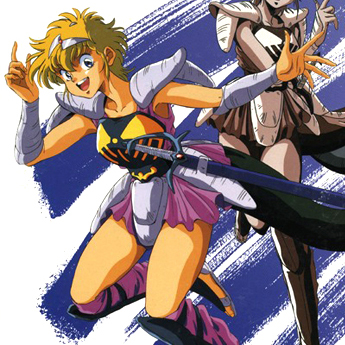
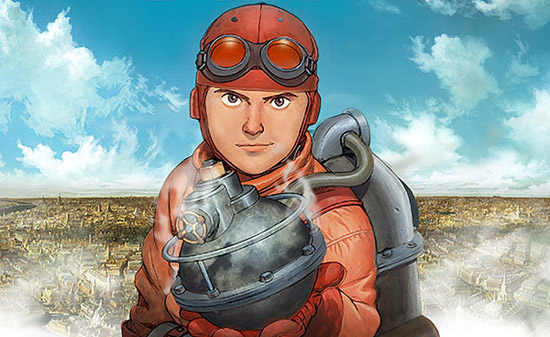
Every decade or so, some visionary artist in Japan (assisted by a horde of animators, background artists, and other technical staff) produces a film of astounding visual brilliance that still manages to split the fandom along partisan lines, resulting in endless quibbling over whether the story should take a backseat to the cinematography. Currently that film is Redline, but eight years ago, that film was Steamboy, directed by anime heavyweight Katsuhiro Otomo, the creator of Akira.
I saw the film only once, on the day of its American home video release in July 2005, when I purchased it for full retail price from the now-defunct video store chain Suncoast Motion Picture Company. I’d be lying if I said Steamboy made much of an impression on me, although dim memories stir of the raging debate on the Internet surrounding the film: “It’s too long.” “The pacing is off.” “The plot is too thin.” “It’s not Akira.”
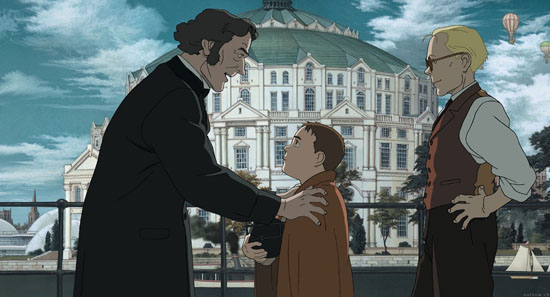
So I dusted off my DVD copy and re-watched the film with a fresh perspective, a perspective colored by more than half a decade of not living in college dorms, of not cooking top ramen for dinner, of having more pressing matters to argue about than the merits of animated films. In short, I watched it as an adult with adult responsibilities and a grown-up perspective, and I’ve come to a conclusion:
Steamboy’s greatest sin? It’s not Akira.
And to that I say: so what? It’s still a beautiful if not Earth-shatteringly profound film.
Set in London and Manchester, England, in a fictional 1866, Steamboy envisions a world populated by the best elements of the “steampunk” subgenre of science fiction. It’s a world of mustaches, monocles, pulsing pistons, bubbling boilers, and cheerful imperialism. Into this world we toss one Ray Steam, an enterprising young man, the third in a family line of amateur inventors. Ray’s life devolves into chaos with the arrival of a mysterious McGuffin sent by his grandfather: a ‘steam ball’ capable of outputting nearly limitless power. Faster than you can say ‘Zounds! My friendly muttonchops have spontaneously combusted!’, Ray finds himself caught in a feud between father and grandfather with the steam ball as the prize and all manner of greedy industrialists and unscrupulous agents of the British Crown vying to possess this brave new technology.
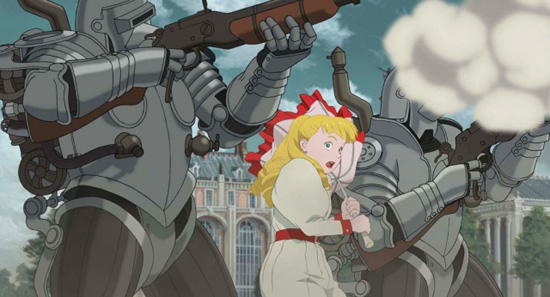
Simply put, this film looks amazing. The attention to detail is superb. From the period costuming and architecture to the luscious backgrounds and the clattering claptrap of the mechanical design, Steamboy is a gorgeous film. And like other visionary directors such as Hayao Miyazaki and the late, lamented Satoshi Kon, Otomo imbues his character designs with a humanity that is universal. From Ray’s stout, long-suffering mother to the balding, meticulous technocrat Simon of the O’hara Foundation, each character is instantly relatable, and each is a mixture of human qualities both admirable and otherwise. And the action sequences—especially the many scenes of urban destruction beneath the wheels, treads, and colossal robot feet of numerous steam-powered monstrosities—are enough to wring a tear from Godzilla’s eye.
So what if the story is straightforward? So what if the science fiction elements are not as radical as those presented in Akira? Steamboy’s approach is more nuanced: there are heroes and villains, but their struggles are not so much good versus evil as ideal versus ideology. Edward Steam—the film’s antagonist, an inventor transformed into a clockwork cyborg by an industrial accident—is a charismatic figure with lofty ideas about dragging humanity to enlightenment through the power of science. His rival, the Thomas Edison analog Robert Stephenson, mouths pleasing platitudes but has no qualms against stealing Steam’s blueprints and using the strong arm of Her Majesty’s military to crush his competitors. Despite the attack-blimps and the suits of primitive powered armor, the O’hara Foundation merely wishes to sell its weapons to the highest bidder. Even the young heiress Scarlett O’hara—a spoiled little princess with a penchant for punching her pet Chihuahua—isn’t entirely irredeemable.
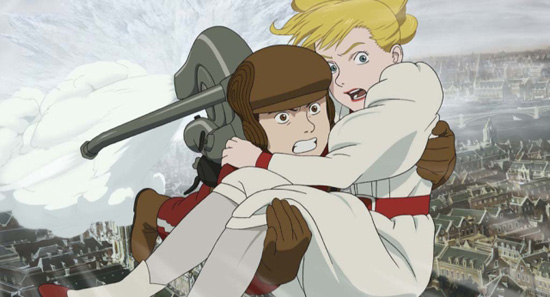
And to all that have complained that the film is poorly paced, I can only reply that such was not my experience. Each plot point presented a problem that needed to be addressed immediately, such that by the end of the movie Ray Steam is tackling problems big enough to threaten the entire city of London. Steamboy entranced me from the opening reel to the ending credit crawl, and considering that these days I have the attention span of a gadfly and that the film is over two hours long, that’s quite an accomplishment.
Ultimately, I think the disappointments expressed about Steamboy result from mismatched expectations: Steampunk is not cyberpunk. Steamboy is not Akira. Otomo is his own stiffest competition. No other animated film has yet matched Otomo’s magnum opus in terms of its pervasive cultural impact and the manner in which it resonated with the zeitgeist of its era. But who knows? Perhaps in another decade or so, people will rediscover the magical world of Ray Steam, a world where mobile battle fortresses can lumber through London on jets of pressurized water vapor, a world where adventure is merely a spanner’s twist away.
Distributor: Sony Picture
Originally released: 2004
Running Time: 126 minutes

Related Stories:
– Katsuhiro Otomo’s Short Peace review
– Tokyo Gallery Hosts Akira Creator Exhibition
– That Katsuhiro Otomo Live-action Film? It Just Might Be Domu
– Akira Creator Announces New Film
– No Movement on Live-action Akira, says Director





